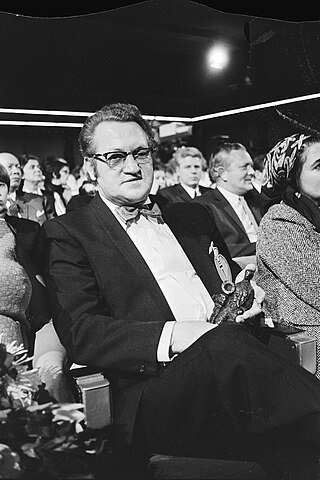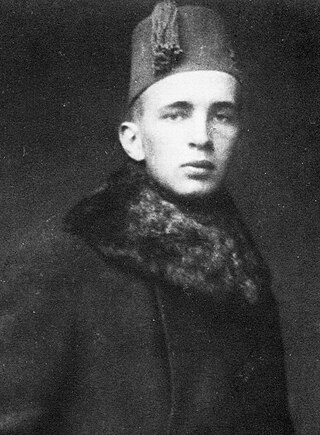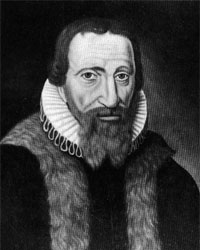
Hermannus Jantinus van Veen is a Dutch stage performer, actor, author, singer-songwriter and musician. He worked with accompanists Laurens van Rooyen and Erik van der Wurff, both of whom were pianists and composers.
De Grootste Nederlander was a public poll held in 2004 by the broadcasting company KRO of the Publieke Omroep. The series has the BBC's 100 Greatest Britons TV format. During the series, it included individual programmes on the top ten, with viewers having further opportunities to vote after each programme.

Johnny Jordaan was the pseudonym for Johannes Hendricus van Musscher, a Dutch singer of popular music, in particular the genre known as levenslied, a Dutch variety of the French chanson. He was well known for his songs about the city of Amsterdam, especially the Jordaan district, which he sang in a typical "hiccuping Mokum vibrato", "Mokum" being the Hebrew-derived nickname for the Amsterdam inner city area. In the 1950s, Johnny Jordaan rose almost instantly to the level of national celebrity and became the "uncrowned king of the Jordaanlied", and his hit song "Geef mij maar Amsterdam" is one of the songs Amsterdammers identify with most.

The Vondelpark is a public urban park of 47 hectares in Amsterdam, Netherlands. It is part of the borough of Amsterdam-Zuid and situated west from the Leidseplein and the Museumplein. The park was opened in 1865 and originally named Nieuwe Park, but later renamed Vondelpark, after the 17th-century playwright and poet Joost van den Vondel. The park has around 10 million visitors annually. Within the park is an open-air theatre, a playground and several food service facilities.

The Netherlands Film Festival is an annual film festival, held in September and October of each year in the city of Utrecht.

Johan Johannes Fabricius, who published in English as Johan Wigmore Fabricius, was a Dutch writer, journalist and adventurer.

Cissy van Bennekom was a Dutch comedy actress. She was born in Haarlem in the Netherlands on 11 July 1911 and died of natural causes on 1 March 2005 in Amsterdam.
Het proces Begeer is a 1918 Dutch silent drama film directed by Theo Frenkel and based on a true story. It follows three criminals who prepare a robbery on the diamond company of the firm Begeer in Amsterdam. It is believed to be a lost film.

The Bluejackets is a 1922 Dutch silent film directed by Maurits Binger.
Het Meisje met de Blauwe Hoed is a 1934 Dutch comedy film directed by Rudolf Meinert.
Een dubbeltje te weinig is a 1991 Dutch film directed by André van Duren and written by Peter van Gestel. It was released internationally under the title A Penny Too Short.
Alex Benno was a Dutch film actor, screenwriter and director of the silent era. He appeared in 15 films between 1913 and 1920.

The Royal Theater Carré is a Neo-Renaissance theatre in Amsterdam, located near the river Amstel. When the theatre was founded in 1887, it was originally meant as a permanent circus building. Currently, it is mainly used for musicals, cabaret performances and pop concerts. Carré is located next to the Amstel, close to Waterlooplein. Its address is Amstel 115 and has approximately 1,700 seats.

The Jordaanlied is a type of levenslied, the Dutch genre of nostalgic sentimental popular music; the Jordaanlied hails from and sings the praises of the Amsterdam neighborhood the Jordaan which, until the 1960s, was an impoverished working-class area. The genre first came to the fore in the late 19th century and reached extraordinary popularity in the 1950s, before becoming old-fashioned quickly when rock and roll came along. It continues to be sung in the now-yuppified Jordaan, as a local favorite and a tourist attraction in a profoundly changed neighborhood; already a nostalgic genre when it was first made popular, the situations it describes and the emotions it evokes are no longer directly accessible even by the older generations, a transformation due in part to the Jordaanlied itself.

Margie Morris was an English stage and silent film actress, revue artist, musician, dancer and singer who worked in the Netherlands during the 1910s and 1920s.

Onze Kunst van Heden was an exhibition held in the winter of 1939 through 1940 at the Rijksmuseum in Amsterdam. Due to the threat of invasion in the years leading up to World War II, the Netherlands' government stored many items from the Rijksmuseum's permanent collection. The resulting empty gallery space was utilized by contemporary Dutch artists to exhibit and sell their art. It was organized by the director of the Rijksmuseum Frederik Schmidt Degener. The show was open to all artists, with each artist allowed to enter four pieces. 902 artists exhibited 3,200 works of art in 74 rooms and cabinets of the Rijksmuseum.
„De kunstenaar kan in tijden van maatschappelijke benauwenis weinig positiefs doen om rampen af te wenden, maar wel kan hij door mede te helpen nationale uitingen op het eigenaardigst naar voren te brengen het gemeenschapsbesef versterken. Wanneer de belangstelling van het publiek uitgaat naar deze manifestatie, die in zulk een omvang in Holland nog niet gezien is, dan zal menige kunstenaar zich op zijn beurt gesterkt voelen".
"The artist can do little positive in times of social distress to avert disasters, but he can, by helping to bring out national expressions in the most idiosyncratic way, strengthen the sense of community. When the public is interested in this event, which has not yet been seen to such an extent in Holland, many artists will feel strengthened in turn."

The Canon of Groningen is a list of 40 hallmarks and 52 icons that provides a chronological summary of the history of the city and province of Groningen.

The Stichting Blauwe Lijn is an organisation based in The Netherlands focused on the preservation of biographical, technical, and historical information related to hydraulic engineering and engineers in the field. The organisation engages in public outreach and educational programmes with the stated aims of:

Heintje Davids , born Hendrika David, was a prominent Dutch variety artist, known for her career as a singer and comedian from 1907 until her death. Performing under the name Henriëtte Davids, she gained widespread fame as Heintje Davids. Her most popular songs included "Zandvoort bij de zee," "Draait," and "Because I Love You So Much," the latter a duet with Sylvain Poons.














